Report on GlaxoSmithKline Business Expansion in Canada
VerifiedAdded on 2021/02/19
|12
|3170
|86
Report
AI Summary
This report provides a comprehensive analysis of GlaxoSmithKline's (GSK) business expansion strategy in Canada. It begins with an introduction to GSK, a multinational pharmaceutical company, including its history, vision, mission, competitors, and product portfolio. The report then delves into the Canadian business environment, highlighting key challenges and opportunities within the pharmaceutical industry. A PESTEL analysis is conducted to evaluate the political, economic, social, technological, environmental, and legal factors influencing GSK's expansion. Furthermore, the report applies Porter's Five Forces model to assess competitive dynamics, including the threats of new entrants, substitutes, and the bargaining power of buyers. The analysis provides insights into how GSK can navigate these challenges to successfully expand its operations in the Canadian market, offering valuable information for students studying business development and market analysis. The report also provides information on the company's background, business strategy and its operations across the globe.
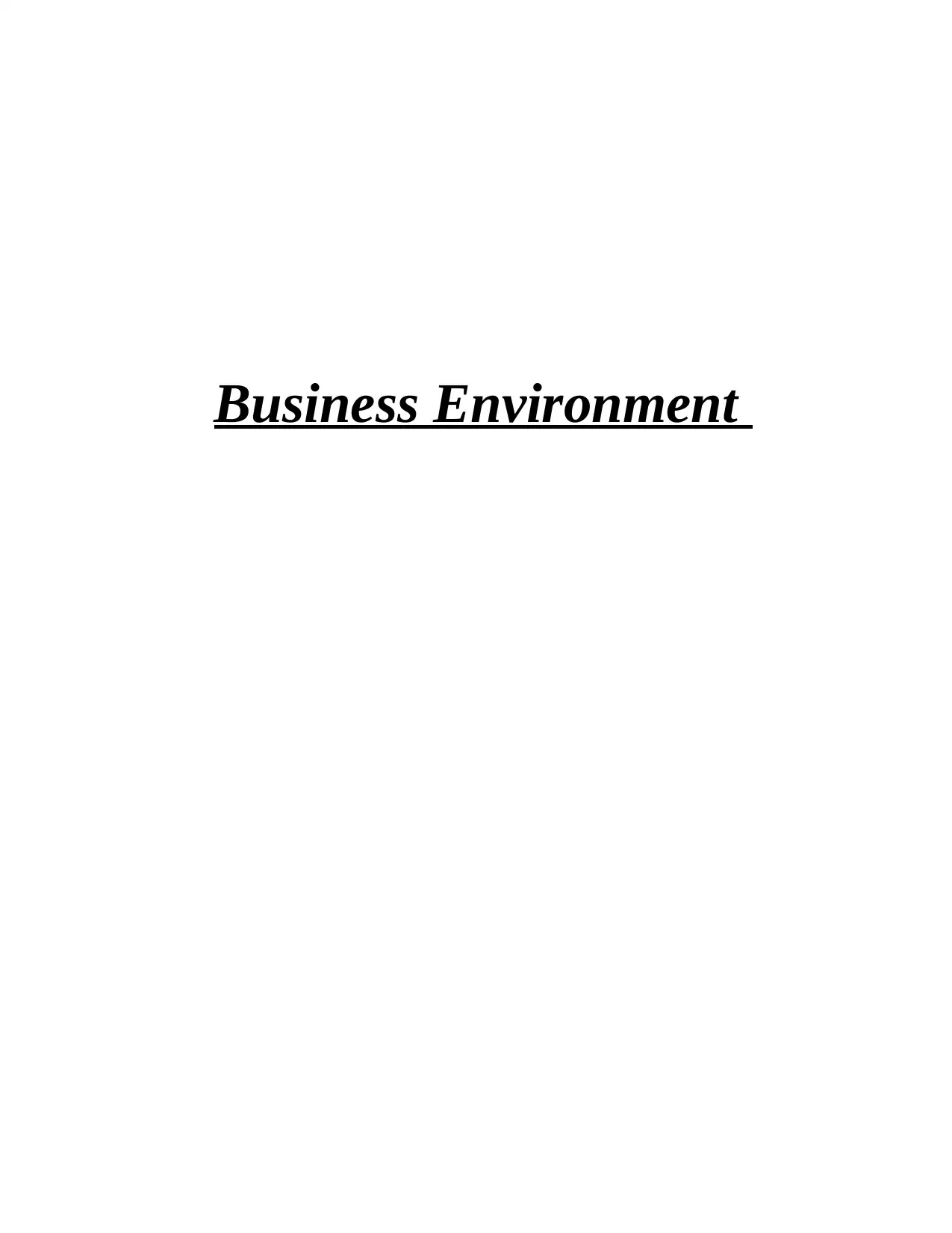
Business Environment
Paraphrase This Document
Need a fresh take? Get an instant paraphrase of this document with our AI Paraphraser

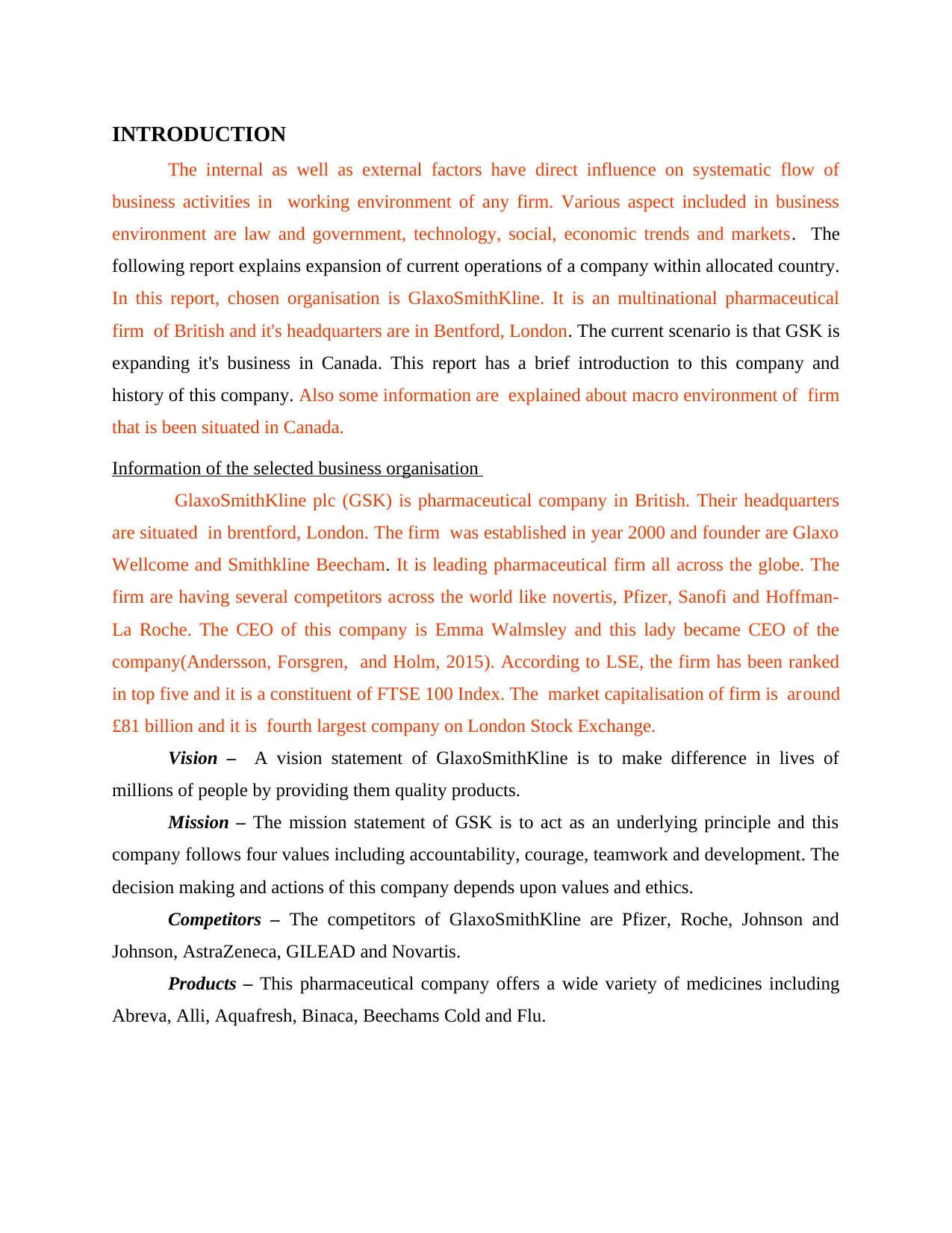
INTRODUCTION
The internal as well as external factors have direct influence on systematic flow of
business activities in working environment of any firm. Various aspect included in business
environment are law and government, technology, social, economic trends and markets. The
following report explains expansion of current operations of a company within allocated country.
In this report, chosen organisation is GlaxoSmithKline. It is an multinational pharmaceutical
firm of British and it's headquarters are in Bentford, London. The current scenario is that GSK is
expanding it's business in Canada. This report has a brief introduction to this company and
history of this company. Also some information are explained about macro environment of firm
that is been situated in Canada.
Information of the selected business organisation
GlaxoSmithKline plc (GSK) is pharmaceutical company in British. Their headquarters
are situated in brentford, London. The firm was established in year 2000 and founder are Glaxo
Wellcome and Smithkline Beecham. It is leading pharmaceutical firm all across the globe. The
firm are having several competitors across the world like novertis, Pfizer, Sanofi and Hoffman-
La Roche. The CEO of this company is Emma Walmsley and this lady became CEO of the
company(Andersson, Forsgren, and Holm, 2015). According to LSE, the firm has been ranked
in top five and it is a constituent of FTSE 100 Index. The market capitalisation of firm is around
£81 billion and it is fourth largest company on London Stock Exchange.
Vision – A vision statement of GlaxoSmithKline is to make difference in lives of
millions of people by providing them quality products.
Mission – The mission statement of GSK is to act as an underlying principle and this
company follows four values including accountability, courage, teamwork and development. The
decision making and actions of this company depends upon values and ethics.
Competitors – The competitors of GlaxoSmithKline are Pfizer, Roche, Johnson and
Johnson, AstraZeneca, GILEAD and Novartis.
Products – This pharmaceutical company offers a wide variety of medicines including
Abreva, Alli, Aquafresh, Binaca, Beechams Cold and Flu.
The internal as well as external factors have direct influence on systematic flow of
business activities in working environment of any firm. Various aspect included in business
environment are law and government, technology, social, economic trends and markets. The
following report explains expansion of current operations of a company within allocated country.
In this report, chosen organisation is GlaxoSmithKline. It is an multinational pharmaceutical
firm of British and it's headquarters are in Bentford, London. The current scenario is that GSK is
expanding it's business in Canada. This report has a brief introduction to this company and
history of this company. Also some information are explained about macro environment of firm
that is been situated in Canada.
Information of the selected business organisation
GlaxoSmithKline plc (GSK) is pharmaceutical company in British. Their headquarters
are situated in brentford, London. The firm was established in year 2000 and founder are Glaxo
Wellcome and Smithkline Beecham. It is leading pharmaceutical firm all across the globe. The
firm are having several competitors across the world like novertis, Pfizer, Sanofi and Hoffman-
La Roche. The CEO of this company is Emma Walmsley and this lady became CEO of the
company(Andersson, Forsgren, and Holm, 2015). According to LSE, the firm has been ranked
in top five and it is a constituent of FTSE 100 Index. The market capitalisation of firm is around
£81 billion and it is fourth largest company on London Stock Exchange.
Vision – A vision statement of GlaxoSmithKline is to make difference in lives of
millions of people by providing them quality products.
Mission – The mission statement of GSK is to act as an underlying principle and this
company follows four values including accountability, courage, teamwork and development. The
decision making and actions of this company depends upon values and ethics.
Competitors – The competitors of GlaxoSmithKline are Pfizer, Roche, Johnson and
Johnson, AstraZeneca, GILEAD and Novartis.
Products – This pharmaceutical company offers a wide variety of medicines including
Abreva, Alli, Aquafresh, Binaca, Beechams Cold and Flu.
⊘ This is a preview!⊘
Do you want full access?
Subscribe today to unlock all pages.

Trusted by 1+ million students worldwide
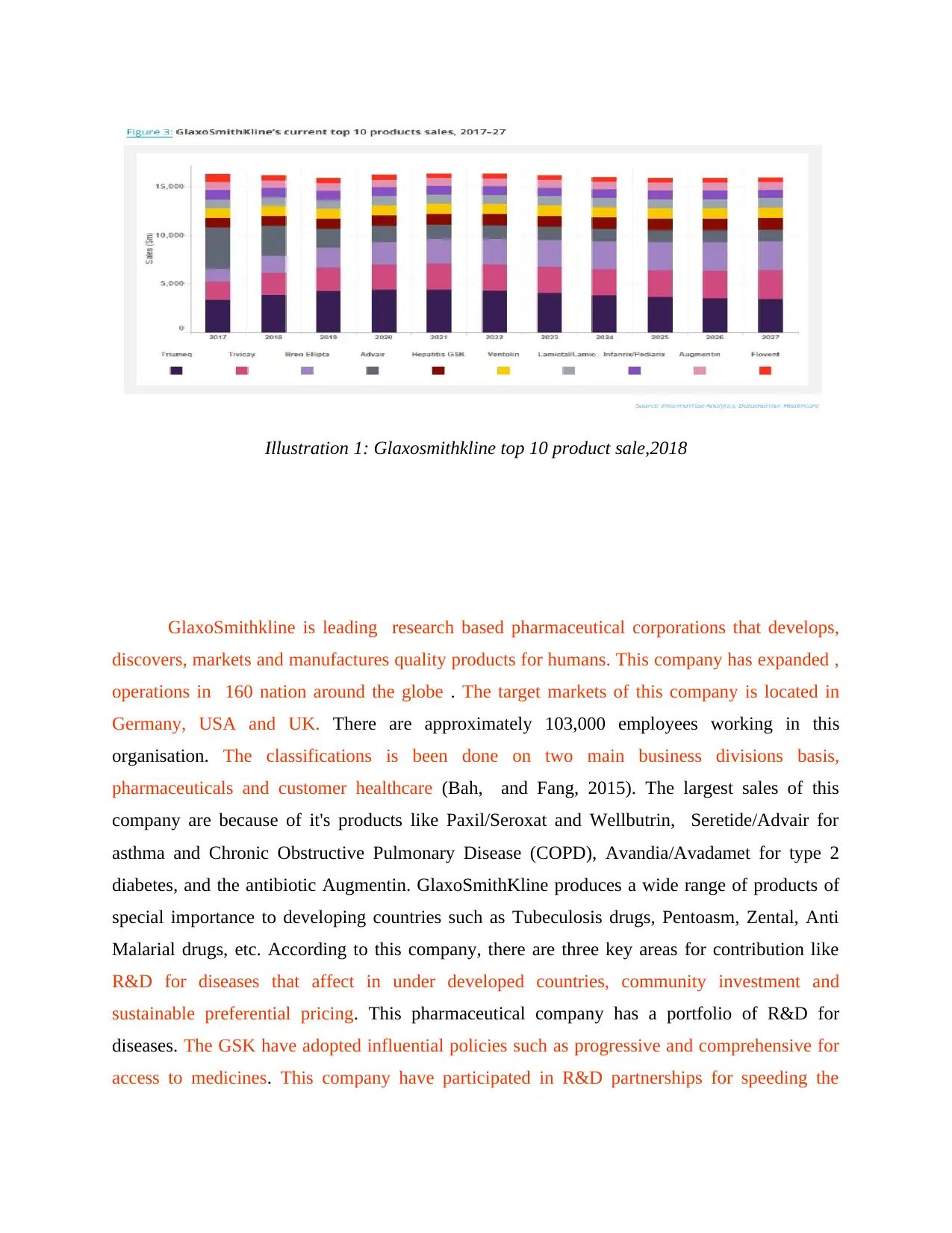
GlaxoSmithkline is leading research based pharmaceutical corporations that develops,
discovers, markets and manufactures quality products for humans. This company has expanded ,
operations in 160 nation around the globe . The target markets of this company is located in
Germany, USA and UK. There are approximately 103,000 employees working in this
organisation. The classifications is been done on two main business divisions basis,
pharmaceuticals and customer healthcare (Bah, and Fang, 2015). The largest sales of this
company are because of it's products like Paxil/Seroxat and Wellbutrin, Seretide/Advair for
asthma and Chronic Obstructive Pulmonary Disease (COPD), Avandia/Avadamet for type 2
diabetes, and the antibiotic Augmentin. GlaxoSmithKline produces a wide range of products of
special importance to developing countries such as Tubeculosis drugs, Pentoasm, Zental, Anti
Malarial drugs, etc. According to this company, there are three key areas for contribution like
R&D for diseases that affect in under developed countries, community investment and
sustainable preferential pricing. This pharmaceutical company has a portfolio of R&D for
diseases. The GSK have adopted influential policies such as progressive and comprehensive for
access to medicines. This company have participated in R&D partnerships for speeding the
Illustration 1: Glaxosmithkline top 10 product sale,2018
discovers, markets and manufactures quality products for humans. This company has expanded ,
operations in 160 nation around the globe . The target markets of this company is located in
Germany, USA and UK. There are approximately 103,000 employees working in this
organisation. The classifications is been done on two main business divisions basis,
pharmaceuticals and customer healthcare (Bah, and Fang, 2015). The largest sales of this
company are because of it's products like Paxil/Seroxat and Wellbutrin, Seretide/Advair for
asthma and Chronic Obstructive Pulmonary Disease (COPD), Avandia/Avadamet for type 2
diabetes, and the antibiotic Augmentin. GlaxoSmithKline produces a wide range of products of
special importance to developing countries such as Tubeculosis drugs, Pentoasm, Zental, Anti
Malarial drugs, etc. According to this company, there are three key areas for contribution like
R&D for diseases that affect in under developed countries, community investment and
sustainable preferential pricing. This pharmaceutical company has a portfolio of R&D for
diseases. The GSK have adopted influential policies such as progressive and comprehensive for
access to medicines. This company have participated in R&D partnerships for speeding the
Illustration 1: Glaxosmithkline top 10 product sale,2018
Paraphrase This Document
Need a fresh take? Get an instant paraphrase of this document with our AI Paraphraser

development of malaria and tuberculosis drugs. This company is partner of two preferential
pricing frameworks- Global Alliance for Vaccines and Immunisation (GAVI) and Accelerating
Access Initiatives (AAI). Companies which participate in AAI offers preferential price for anti-
retrovirals. In poor countries, GSK provides a single not-for-profit price. GAVI was established
in the year 1999 for expanding use of vaccines in different developing countries. The GAVI is
focusing on three diseases i.e. Hepatitis B, yellow fever and Haemophilus influenza type b. In
the period of 2001-2004, GSK is the major supplier of Hepatitis B vaccines.
Background information of Glaxo Smith Kline
GlaxoSmithKline is a public limited company. The firm market shares are held by a
London based group of large institutional investor. GSK offers R&D in more than 20 sites and it
has employed around 15,000 for conducting R&D. The main principal facilities are situated in
Belgium, Italy, Japan, UK and USA. The minor R&D sites are situated in Spain, France and
Canada. Belgium is the country where all vaccines are carried out for R&D. GSK has partnership
Illustration 2: Turnover analysis, 2016
pricing frameworks- Global Alliance for Vaccines and Immunisation (GAVI) and Accelerating
Access Initiatives (AAI). Companies which participate in AAI offers preferential price for anti-
retrovirals. In poor countries, GSK provides a single not-for-profit price. GAVI was established
in the year 1999 for expanding use of vaccines in different developing countries. The GAVI is
focusing on three diseases i.e. Hepatitis B, yellow fever and Haemophilus influenza type b. In
the period of 2001-2004, GSK is the major supplier of Hepatitis B vaccines.
Background information of Glaxo Smith Kline
GlaxoSmithKline is a public limited company. The firm market shares are held by a
London based group of large institutional investor. GSK offers R&D in more than 20 sites and it
has employed around 15,000 for conducting R&D. The main principal facilities are situated in
Belgium, Italy, Japan, UK and USA. The minor R&D sites are situated in Spain, France and
Canada. Belgium is the country where all vaccines are carried out for R&D. GSK has partnership
Illustration 2: Turnover analysis, 2016
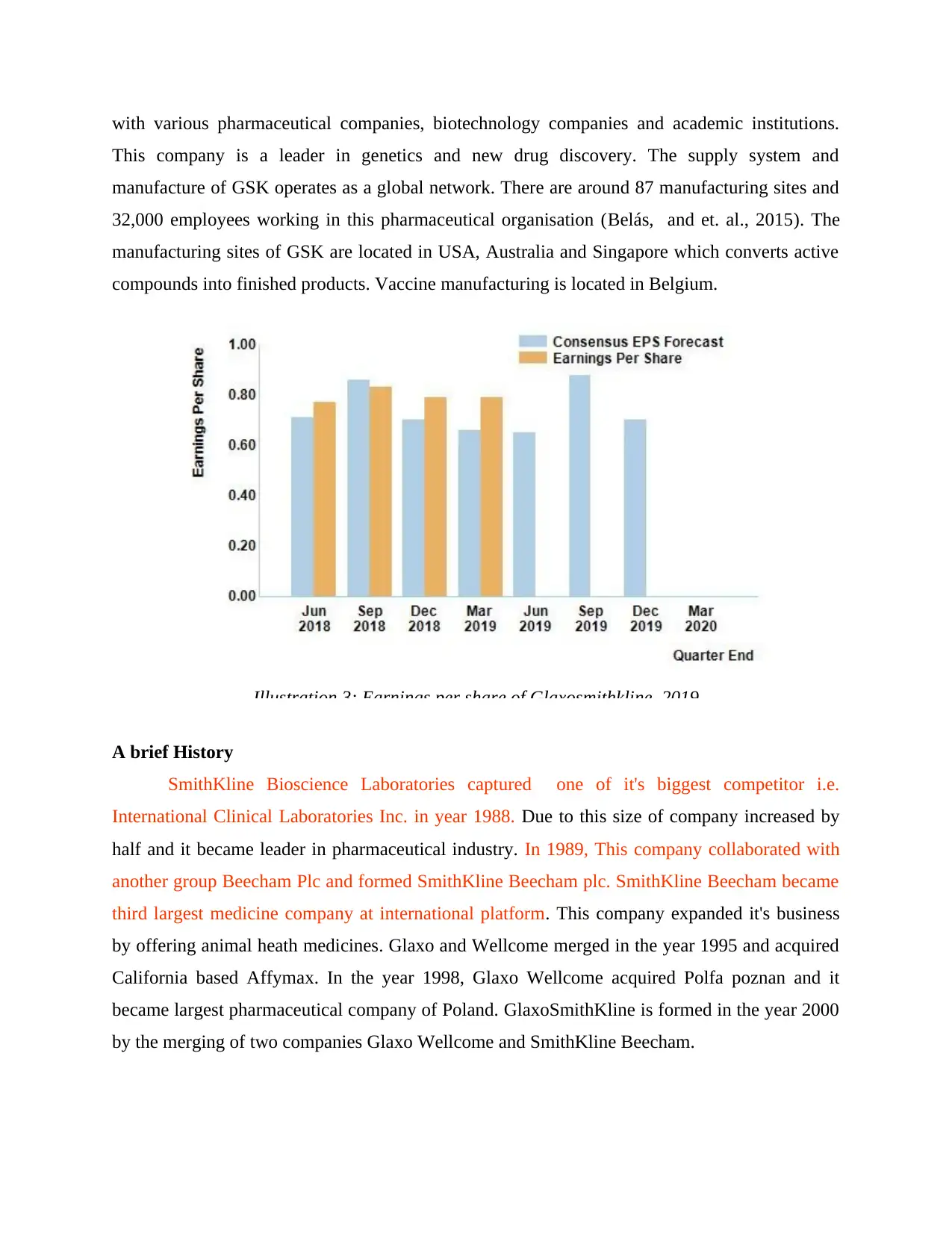
with various pharmaceutical companies, biotechnology companies and academic institutions.
This company is a leader in genetics and new drug discovery. The supply system and
manufacture of GSK operates as a global network. There are around 87 manufacturing sites and
32,000 employees working in this pharmaceutical organisation (Belás, and et. al., 2015). The
manufacturing sites of GSK are located in USA, Australia and Singapore which converts active
compounds into finished products. Vaccine manufacturing is located in Belgium.
A brief History
SmithKline Bioscience Laboratories captured one of it's biggest competitor i.e.
International Clinical Laboratories Inc. in year 1988. Due to this size of company increased by
half and it became leader in pharmaceutical industry. In 1989, This company collaborated with
another group Beecham Plc and formed SmithKline Beecham plc. SmithKline Beecham became
third largest medicine company at international platform. This company expanded it's business
by offering animal heath medicines. Glaxo and Wellcome merged in the year 1995 and acquired
California based Affymax. In the year 1998, Glaxo Wellcome acquired Polfa poznan and it
became largest pharmaceutical company of Poland. GlaxoSmithKline is formed in the year 2000
by the merging of two companies Glaxo Wellcome and SmithKline Beecham.
Illustration 3: Earnings per share of Glaxosmithkline, 2019
This company is a leader in genetics and new drug discovery. The supply system and
manufacture of GSK operates as a global network. There are around 87 manufacturing sites and
32,000 employees working in this pharmaceutical organisation (Belás, and et. al., 2015). The
manufacturing sites of GSK are located in USA, Australia and Singapore which converts active
compounds into finished products. Vaccine manufacturing is located in Belgium.
A brief History
SmithKline Bioscience Laboratories captured one of it's biggest competitor i.e.
International Clinical Laboratories Inc. in year 1988. Due to this size of company increased by
half and it became leader in pharmaceutical industry. In 1989, This company collaborated with
another group Beecham Plc and formed SmithKline Beecham plc. SmithKline Beecham became
third largest medicine company at international platform. This company expanded it's business
by offering animal heath medicines. Glaxo and Wellcome merged in the year 1995 and acquired
California based Affymax. In the year 1998, Glaxo Wellcome acquired Polfa poznan and it
became largest pharmaceutical company of Poland. GlaxoSmithKline is formed in the year 2000
by the merging of two companies Glaxo Wellcome and SmithKline Beecham.
Illustration 3: Earnings per share of Glaxosmithkline, 2019
⊘ This is a preview!⊘
Do you want full access?
Subscribe today to unlock all pages.

Trusted by 1+ million students worldwide

Business strategy
The main objective of GSK is to become leader of pharmaceutical industry in the world.
For doing so, this company has to improve R&D pipeline. The desired objective could be
attained by using selective in-licensing agreements for external contracting of R&D and a
focused drug portfolio strategy. This company connects R&D to commercial operations for
maximising value of R&D portfolio. An important factor of GSK is direct to consumer
advertising strategy (Georgescu, and Popescul, 2015). Consumers who receive information by
DTC advertising requests for particular brand name medicines to physicians. This company is
improving sales force excellence for creating image GSK, among healthcare professionals.
Background information on the business Environment (Canada)
The pharmaceutical industry in Canada is facing several challenges as it is going
tremendous changes due to technological development. The market of Canada is the 8th largest
market of the world and it is accounted for 2.6% of total global purchases. The Canadian
pharmaceutical company has increased after decline in the year 2011. the performance of
Canadian industry is affected by restrictive market access and pricing policies for brands.
Companies that are looking for lowering cost of medicine that shifted market share towards
generic segment.
Analysis of Business Scenario
PESTEL analysis
GlaxosmithKline is operating in Canada at a small scale (Ren, and et. al., 2017). This
company in Canada is involved in making a wide range of prescribed vaccines, prescription
medicines and healthcare products of consumers. If this wants to expand its business in Canada
then there should be analysis done for knowing the effectiveness of business expansion. The
PESTEL analysis for expansion of business of Glaxosmithkline is explained below -
Political -The political factors affects the expansion of business. There are various factors
that affects business operations such as unstable government rules, international trade
regulations, trade control and increased taxes. In Canada there is increase in focus of politics on
healthcare authorities and thus it is more essential for Glaxosmithkline to work effectively if it
wants to start it's business at a large scale in Canada. Some of the questions raised by
government are pricing pressure, services efficiency, drug testing, etc.
The main objective of GSK is to become leader of pharmaceutical industry in the world.
For doing so, this company has to improve R&D pipeline. The desired objective could be
attained by using selective in-licensing agreements for external contracting of R&D and a
focused drug portfolio strategy. This company connects R&D to commercial operations for
maximising value of R&D portfolio. An important factor of GSK is direct to consumer
advertising strategy (Georgescu, and Popescul, 2015). Consumers who receive information by
DTC advertising requests for particular brand name medicines to physicians. This company is
improving sales force excellence for creating image GSK, among healthcare professionals.
Background information on the business Environment (Canada)
The pharmaceutical industry in Canada is facing several challenges as it is going
tremendous changes due to technological development. The market of Canada is the 8th largest
market of the world and it is accounted for 2.6% of total global purchases. The Canadian
pharmaceutical company has increased after decline in the year 2011. the performance of
Canadian industry is affected by restrictive market access and pricing policies for brands.
Companies that are looking for lowering cost of medicine that shifted market share towards
generic segment.
Analysis of Business Scenario
PESTEL analysis
GlaxosmithKline is operating in Canada at a small scale (Ren, and et. al., 2017). This
company in Canada is involved in making a wide range of prescribed vaccines, prescription
medicines and healthcare products of consumers. If this wants to expand its business in Canada
then there should be analysis done for knowing the effectiveness of business expansion. The
PESTEL analysis for expansion of business of Glaxosmithkline is explained below -
Political -The political factors affects the expansion of business. There are various factors
that affects business operations such as unstable government rules, international trade
regulations, trade control and increased taxes. In Canada there is increase in focus of politics on
healthcare authorities and thus it is more essential for Glaxosmithkline to work effectively if it
wants to start it's business at a large scale in Canada. Some of the questions raised by
government are pricing pressure, services efficiency, drug testing, etc.
Paraphrase This Document
Need a fresh take? Get an instant paraphrase of this document with our AI Paraphraser
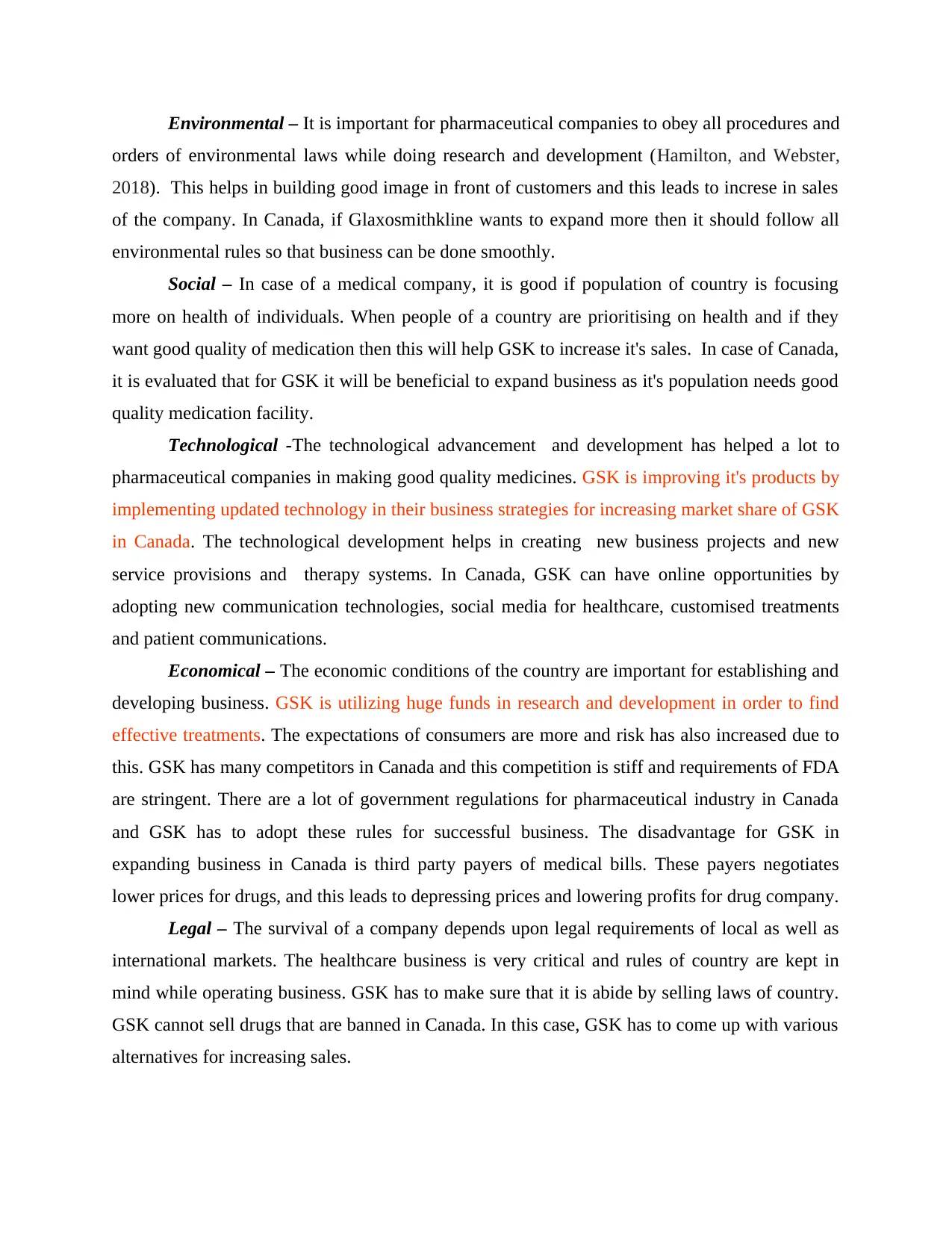
Environmental – It is important for pharmaceutical companies to obey all procedures and
orders of environmental laws while doing research and development (Hamilton, and Webster,
2018). This helps in building good image in front of customers and this leads to increse in sales
of the company. In Canada, if Glaxosmithkline wants to expand more then it should follow all
environmental rules so that business can be done smoothly.
Social – In case of a medical company, it is good if population of country is focusing
more on health of individuals. When people of a country are prioritising on health and if they
want good quality of medication then this will help GSK to increase it's sales. In case of Canada,
it is evaluated that for GSK it will be beneficial to expand business as it's population needs good
quality medication facility.
Technological -The technological advancement and development has helped a lot to
pharmaceutical companies in making good quality medicines. GSK is improving it's products by
implementing updated technology in their business strategies for increasing market share of GSK
in Canada. The technological development helps in creating new business projects and new
service provisions and therapy systems. In Canada, GSK can have online opportunities by
adopting new communication technologies, social media for healthcare, customised treatments
and patient communications.
Economical – The economic conditions of the country are important for establishing and
developing business. GSK is utilizing huge funds in research and development in order to find
effective treatments. The expectations of consumers are more and risk has also increased due to
this. GSK has many competitors in Canada and this competition is stiff and requirements of FDA
are stringent. There are a lot of government regulations for pharmaceutical industry in Canada
and GSK has to adopt these rules for successful business. The disadvantage for GSK in
expanding business in Canada is third party payers of medical bills. These payers negotiates
lower prices for drugs, and this leads to depressing prices and lowering profits for drug company.
Legal – The survival of a company depends upon legal requirements of local as well as
international markets. The healthcare business is very critical and rules of country are kept in
mind while operating business. GSK has to make sure that it is abide by selling laws of country.
GSK cannot sell drugs that are banned in Canada. In this case, GSK has to come up with various
alternatives for increasing sales.
orders of environmental laws while doing research and development (Hamilton, and Webster,
2018). This helps in building good image in front of customers and this leads to increse in sales
of the company. In Canada, if Glaxosmithkline wants to expand more then it should follow all
environmental rules so that business can be done smoothly.
Social – In case of a medical company, it is good if population of country is focusing
more on health of individuals. When people of a country are prioritising on health and if they
want good quality of medication then this will help GSK to increase it's sales. In case of Canada,
it is evaluated that for GSK it will be beneficial to expand business as it's population needs good
quality medication facility.
Technological -The technological advancement and development has helped a lot to
pharmaceutical companies in making good quality medicines. GSK is improving it's products by
implementing updated technology in their business strategies for increasing market share of GSK
in Canada. The technological development helps in creating new business projects and new
service provisions and therapy systems. In Canada, GSK can have online opportunities by
adopting new communication technologies, social media for healthcare, customised treatments
and patient communications.
Economical – The economic conditions of the country are important for establishing and
developing business. GSK is utilizing huge funds in research and development in order to find
effective treatments. The expectations of consumers are more and risk has also increased due to
this. GSK has many competitors in Canada and this competition is stiff and requirements of FDA
are stringent. There are a lot of government regulations for pharmaceutical industry in Canada
and GSK has to adopt these rules for successful business. The disadvantage for GSK in
expanding business in Canada is third party payers of medical bills. These payers negotiates
lower prices for drugs, and this leads to depressing prices and lowering profits for drug company.
Legal – The survival of a company depends upon legal requirements of local as well as
international markets. The healthcare business is very critical and rules of country are kept in
mind while operating business. GSK has to make sure that it is abide by selling laws of country.
GSK cannot sell drugs that are banned in Canada. In this case, GSK has to come up with various
alternatives for increasing sales.

Porter's Five Forces Model
According to Porter, there are five forces that are helpful in analysing framework and
business strategy of Glaxosmithkline. These five forces are threats of substitutes, bargaining
power of buyers and suppliers, new entrants and rivalry with competitors.
Threats of new Entrants - The marketing team have to critically conduct as research on
external barriers that will impact on business operations in pharmaceutical industry. Thus, there
is no worry about threat of new entrants (Kolk, 2016). The firm could develop through
acquisitions with mergers small scale business. GlaxoSmithKline has to deal with various new
developments for capitalising on brand name. In Canada, GSK has less threat of new entrants.
How GlaxoSmithKline can overcome threat of new entrants
By adopting innovations and new technology in product and services. This will help GSK
to attract new customers as well as provide old customers a reason to buy products.
New entrants have to spend a lot to establish their business in pharmaceutical industry.
This reduces profit of new firms and this can lead to demotivation of new players of the
industry.
Threat of Substitutes – This factor states that if a new product is been introduced in
market, should able to meet the needs of customers, then profitability of business is affected
badly. This is important for GSK to analyse the products which can be used as substitute. It must
improve it's products in an effective manner.
How GlaxoSmithKline can overcome threat of substitutes
By analysing the needs and demands of customers in an effective manner.
GSK can tackle the problem of threat of substitute by becoming service oriented and not
product oriented. By maximising the switching cost for consumers.
Bargaining Power of Buyer – The buying power has been recently increased in market
These people want to buy quality products by paying the minimum cost. This creates pressure for
GSK's profitability in long time. When the power of customers is higher than there will be
increase in discounts and offers.
According to Porter, there are five forces that are helpful in analysing framework and
business strategy of Glaxosmithkline. These five forces are threats of substitutes, bargaining
power of buyers and suppliers, new entrants and rivalry with competitors.
Threats of new Entrants - The marketing team have to critically conduct as research on
external barriers that will impact on business operations in pharmaceutical industry. Thus, there
is no worry about threat of new entrants (Kolk, 2016). The firm could develop through
acquisitions with mergers small scale business. GlaxoSmithKline has to deal with various new
developments for capitalising on brand name. In Canada, GSK has less threat of new entrants.
How GlaxoSmithKline can overcome threat of new entrants
By adopting innovations and new technology in product and services. This will help GSK
to attract new customers as well as provide old customers a reason to buy products.
New entrants have to spend a lot to establish their business in pharmaceutical industry.
This reduces profit of new firms and this can lead to demotivation of new players of the
industry.
Threat of Substitutes – This factor states that if a new product is been introduced in
market, should able to meet the needs of customers, then profitability of business is affected
badly. This is important for GSK to analyse the products which can be used as substitute. It must
improve it's products in an effective manner.
How GlaxoSmithKline can overcome threat of substitutes
By analysing the needs and demands of customers in an effective manner.
GSK can tackle the problem of threat of substitute by becoming service oriented and not
product oriented. By maximising the switching cost for consumers.
Bargaining Power of Buyer – The buying power has been recently increased in market
These people want to buy quality products by paying the minimum cost. This creates pressure for
GSK's profitability in long time. When the power of customers is higher than there will be
increase in discounts and offers.
⊘ This is a preview!⊘
Do you want full access?
Subscribe today to unlock all pages.

Trusted by 1+ million students worldwide
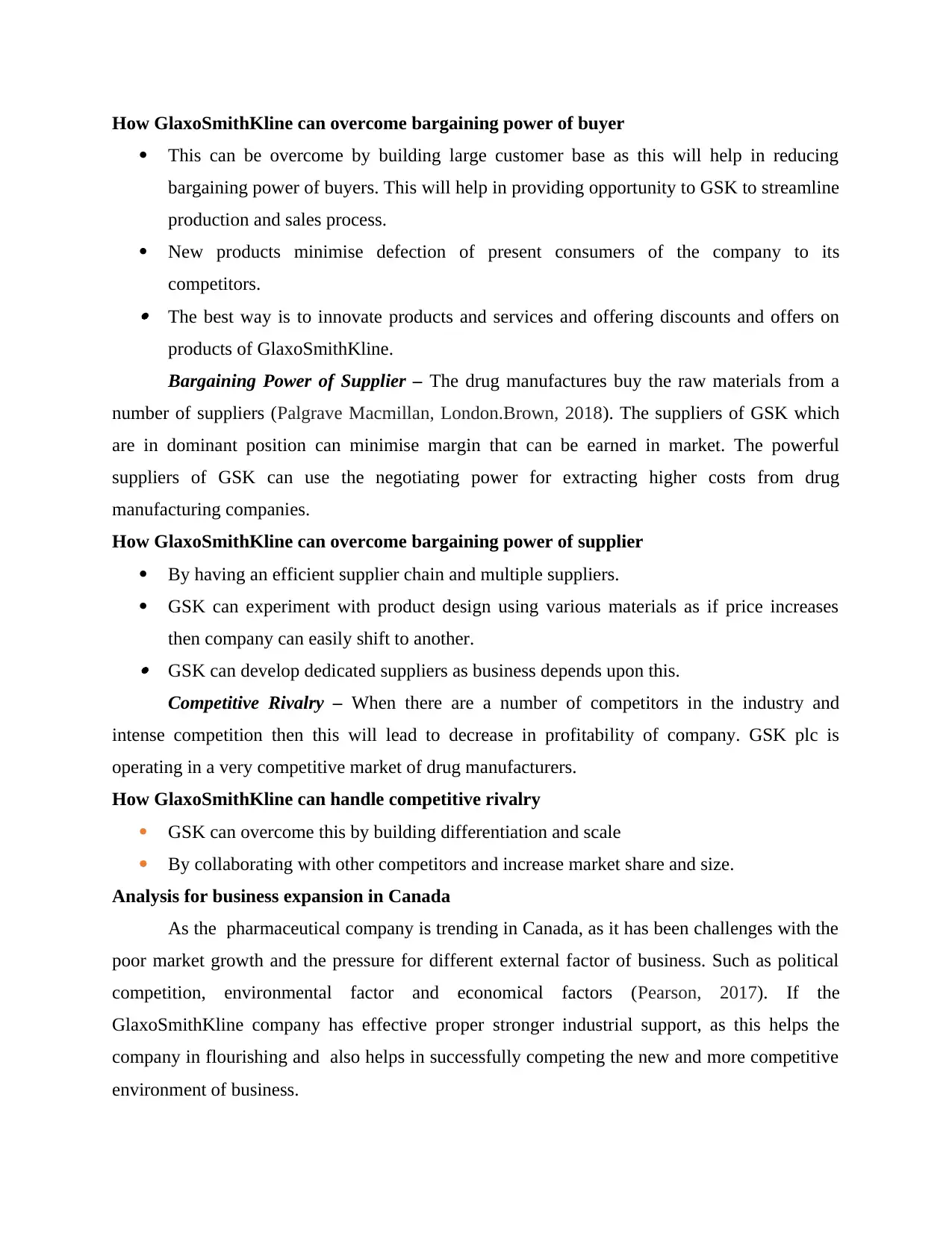
How GlaxoSmithKline can overcome bargaining power of buyer
This can be overcome by building large customer base as this will help in reducing
bargaining power of buyers. This will help in providing opportunity to GSK to streamline
production and sales process.
New products minimise defection of present consumers of the company to its
competitors. The best way is to innovate products and services and offering discounts and offers on
products of GlaxoSmithKline.
Bargaining Power of Supplier – The drug manufactures buy the raw materials from a
number of suppliers (Palgrave Macmillan, London.Brown, 2018). The suppliers of GSK which
are in dominant position can minimise margin that can be earned in market. The powerful
suppliers of GSK can use the negotiating power for extracting higher costs from drug
manufacturing companies.
How GlaxoSmithKline can overcome bargaining power of supplier
By having an efficient supplier chain and multiple suppliers.
GSK can experiment with product design using various materials as if price increases
then company can easily shift to another. GSK can develop dedicated suppliers as business depends upon this.
Competitive Rivalry – When there are a number of competitors in the industry and
intense competition then this will lead to decrease in profitability of company. GSK plc is
operating in a very competitive market of drug manufacturers.
How GlaxoSmithKline can handle competitive rivalry
GSK can overcome this by building differentiation and scale
By collaborating with other competitors and increase market share and size.
Analysis for business expansion in Canada
As the pharmaceutical company is trending in Canada, as it has been challenges with the
poor market growth and the pressure for different external factor of business. Such as political
competition, environmental factor and economical factors (Pearson, 2017). If the
GlaxoSmithKline company has effective proper stronger industrial support, as this helps the
company in flourishing and also helps in successfully competing the new and more competitive
environment of business.
This can be overcome by building large customer base as this will help in reducing
bargaining power of buyers. This will help in providing opportunity to GSK to streamline
production and sales process.
New products minimise defection of present consumers of the company to its
competitors. The best way is to innovate products and services and offering discounts and offers on
products of GlaxoSmithKline.
Bargaining Power of Supplier – The drug manufactures buy the raw materials from a
number of suppliers (Palgrave Macmillan, London.Brown, 2018). The suppliers of GSK which
are in dominant position can minimise margin that can be earned in market. The powerful
suppliers of GSK can use the negotiating power for extracting higher costs from drug
manufacturing companies.
How GlaxoSmithKline can overcome bargaining power of supplier
By having an efficient supplier chain and multiple suppliers.
GSK can experiment with product design using various materials as if price increases
then company can easily shift to another. GSK can develop dedicated suppliers as business depends upon this.
Competitive Rivalry – When there are a number of competitors in the industry and
intense competition then this will lead to decrease in profitability of company. GSK plc is
operating in a very competitive market of drug manufacturers.
How GlaxoSmithKline can handle competitive rivalry
GSK can overcome this by building differentiation and scale
By collaborating with other competitors and increase market share and size.
Analysis for business expansion in Canada
As the pharmaceutical company is trending in Canada, as it has been challenges with the
poor market growth and the pressure for different external factor of business. Such as political
competition, environmental factor and economical factors (Pearson, 2017). If the
GlaxoSmithKline company has effective proper stronger industrial support, as this helps the
company in flourishing and also helps in successfully competing the new and more competitive
environment of business.
Paraphrase This Document
Need a fresh take? Get an instant paraphrase of this document with our AI Paraphraser
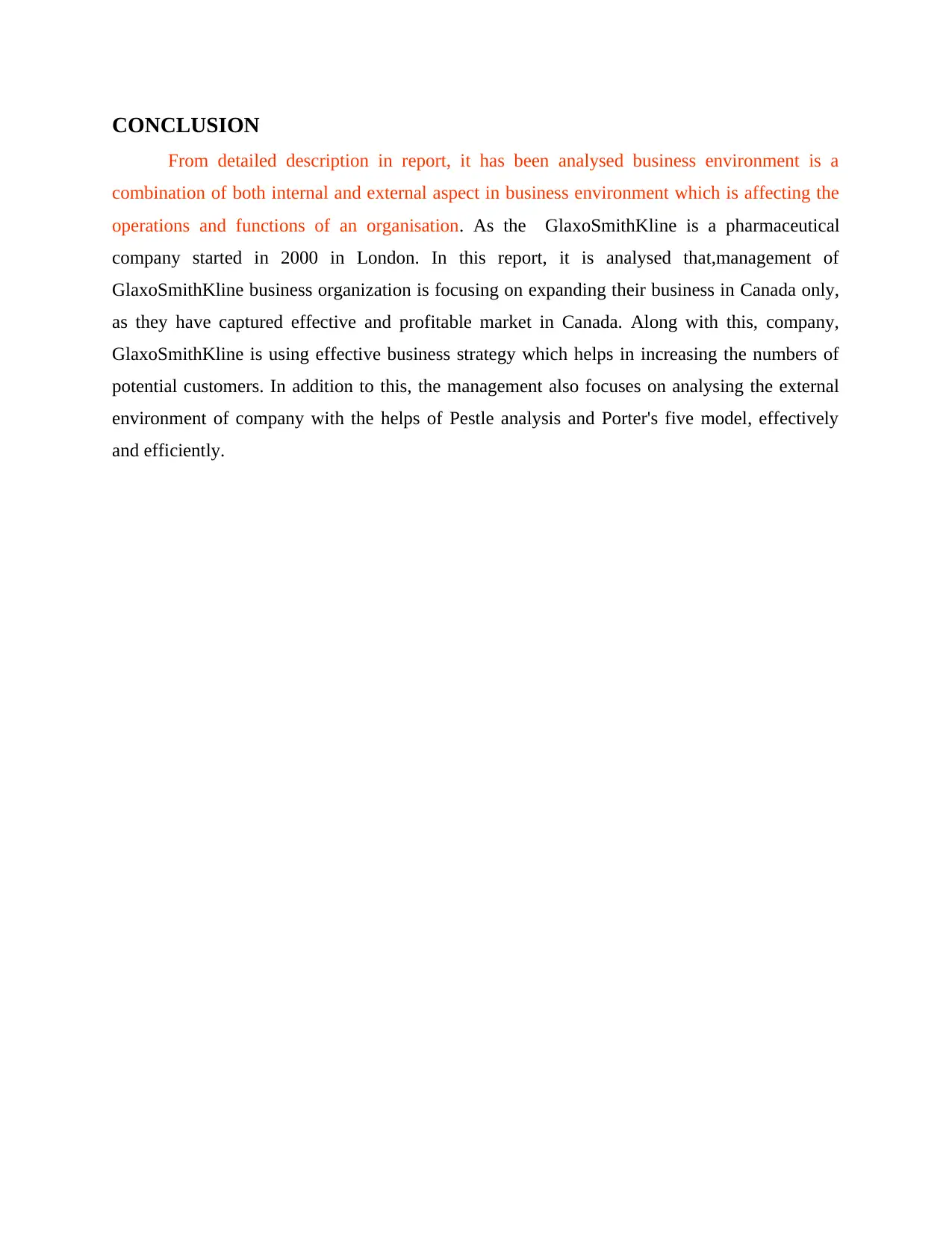
CONCLUSION
From detailed description in report, it has been analysed business environment is a
combination of both internal and external aspect in business environment which is affecting the
operations and functions of an organisation. As the GlaxoSmithKline is a pharmaceutical
company started in 2000 in London. In this report, it is analysed that,management of
GlaxoSmithKline business organization is focusing on expanding their business in Canada only,
as they have captured effective and profitable market in Canada. Along with this, company,
GlaxoSmithKline is using effective business strategy which helps in increasing the numbers of
potential customers. In addition to this, the management also focuses on analysing the external
environment of company with the helps of Pestle analysis and Porter's five model, effectively
and efficiently.
From detailed description in report, it has been analysed business environment is a
combination of both internal and external aspect in business environment which is affecting the
operations and functions of an organisation. As the GlaxoSmithKline is a pharmaceutical
company started in 2000 in London. In this report, it is analysed that,management of
GlaxoSmithKline business organization is focusing on expanding their business in Canada only,
as they have captured effective and profitable market in Canada. Along with this, company,
GlaxoSmithKline is using effective business strategy which helps in increasing the numbers of
potential customers. In addition to this, the management also focuses on analysing the external
environment of company with the helps of Pestle analysis and Porter's five model, effectively
and efficiently.
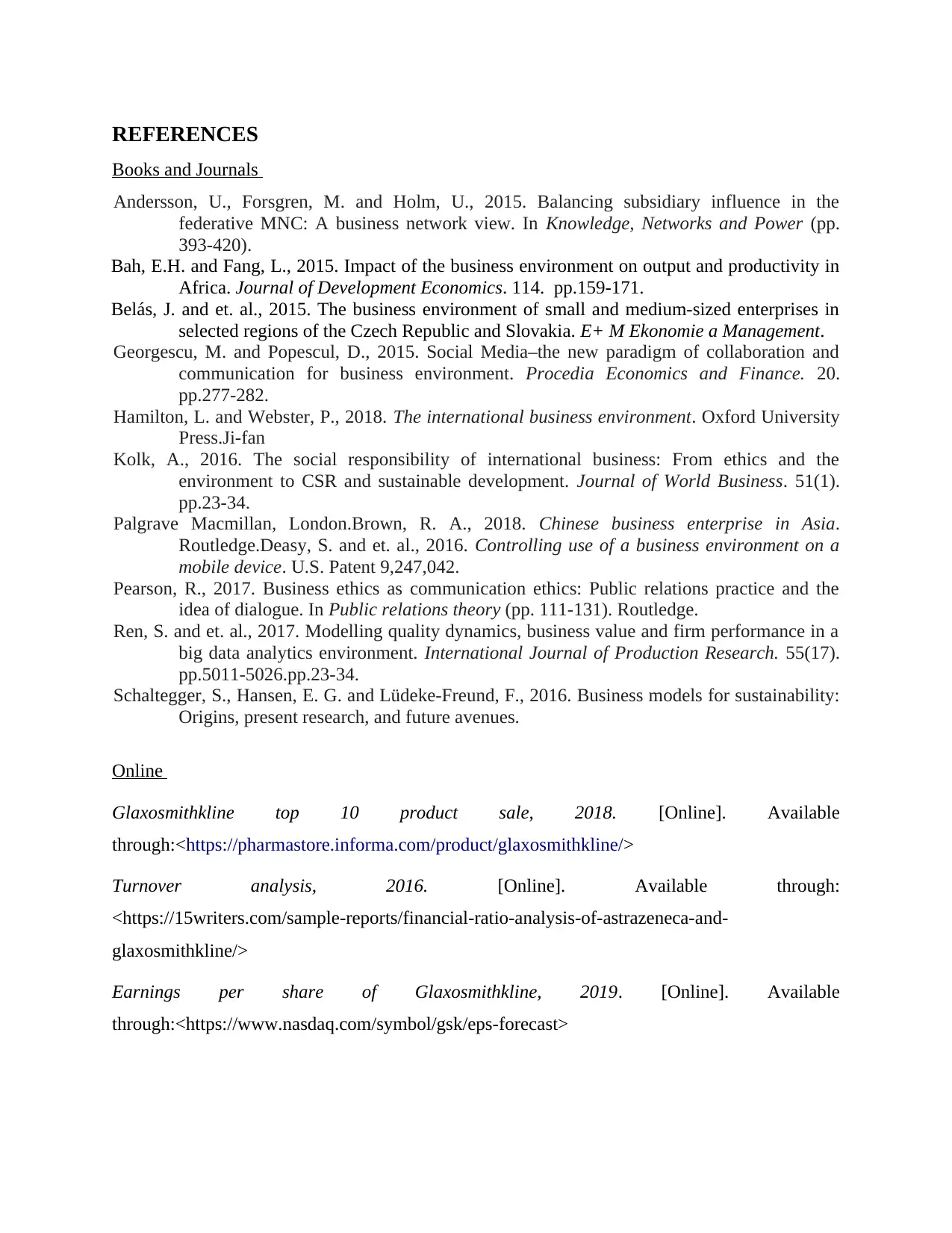
REFERENCES
Books and Journals
Andersson, U., Forsgren, M. and Holm, U., 2015. Balancing subsidiary influence in the
federative MNC: A business network view. In Knowledge, Networks and Power (pp.
393-420).
Bah, E.H. and Fang, L., 2015. Impact of the business environment on output and productivity in
Africa. Journal of Development Economics. 114. pp.159-171.
Belás, J. and et. al., 2015. The business environment of small and medium-sized enterprises in
selected regions of the Czech Republic and Slovakia. E+ M Ekonomie a Management.
Georgescu, M. and Popescul, D., 2015. Social Media–the new paradigm of collaboration and
communication for business environment. Procedia Economics and Finance. 20.
pp.277-282.
Hamilton, L. and Webster, P., 2018. The international business environment. Oxford University
Press.Ji-fan
Kolk, A., 2016. The social responsibility of international business: From ethics and the
environment to CSR and sustainable development. Journal of World Business. 51(1).
pp.23-34.
Palgrave Macmillan, London.Brown, R. A., 2018. Chinese business enterprise in Asia.
Routledge.Deasy, S. and et. al., 2016. Controlling use of a business environment on a
mobile device. U.S. Patent 9,247,042.
Pearson, R., 2017. Business ethics as communication ethics: Public relations practice and the
idea of dialogue. In Public relations theory (pp. 111-131). Routledge.
Ren, S. and et. al., 2017. Modelling quality dynamics, business value and firm performance in a
big data analytics environment. International Journal of Production Research. 55(17).
pp.5011-5026.pp.23-34.
Schaltegger, S., Hansen, E. G. and Lüdeke-Freund, F., 2016. Business models for sustainability:
Origins, present research, and future avenues.
Online
Glaxosmithkline top 10 product sale, 2018. [Online]. Available
through:<https://pharmastore.informa.com/product/glaxosmithkline/>
Turnover analysis, 2016. [Online]. Available through:
<https://15writers.com/sample-reports/financial-ratio-analysis-of-astrazeneca-and-
glaxosmithkline/>
Earnings per share of Glaxosmithkline, 2019. [Online]. Available
through:<https://www.nasdaq.com/symbol/gsk/eps-forecast>
Books and Journals
Andersson, U., Forsgren, M. and Holm, U., 2015. Balancing subsidiary influence in the
federative MNC: A business network view. In Knowledge, Networks and Power (pp.
393-420).
Bah, E.H. and Fang, L., 2015. Impact of the business environment on output and productivity in
Africa. Journal of Development Economics. 114. pp.159-171.
Belás, J. and et. al., 2015. The business environment of small and medium-sized enterprises in
selected regions of the Czech Republic and Slovakia. E+ M Ekonomie a Management.
Georgescu, M. and Popescul, D., 2015. Social Media–the new paradigm of collaboration and
communication for business environment. Procedia Economics and Finance. 20.
pp.277-282.
Hamilton, L. and Webster, P., 2018. The international business environment. Oxford University
Press.Ji-fan
Kolk, A., 2016. The social responsibility of international business: From ethics and the
environment to CSR and sustainable development. Journal of World Business. 51(1).
pp.23-34.
Palgrave Macmillan, London.Brown, R. A., 2018. Chinese business enterprise in Asia.
Routledge.Deasy, S. and et. al., 2016. Controlling use of a business environment on a
mobile device. U.S. Patent 9,247,042.
Pearson, R., 2017. Business ethics as communication ethics: Public relations practice and the
idea of dialogue. In Public relations theory (pp. 111-131). Routledge.
Ren, S. and et. al., 2017. Modelling quality dynamics, business value and firm performance in a
big data analytics environment. International Journal of Production Research. 55(17).
pp.5011-5026.pp.23-34.
Schaltegger, S., Hansen, E. G. and Lüdeke-Freund, F., 2016. Business models for sustainability:
Origins, present research, and future avenues.
Online
Glaxosmithkline top 10 product sale, 2018. [Online]. Available
through:<https://pharmastore.informa.com/product/glaxosmithkline/>
Turnover analysis, 2016. [Online]. Available through:
<https://15writers.com/sample-reports/financial-ratio-analysis-of-astrazeneca-and-
glaxosmithkline/>
Earnings per share of Glaxosmithkline, 2019. [Online]. Available
through:<https://www.nasdaq.com/symbol/gsk/eps-forecast>
⊘ This is a preview!⊘
Do you want full access?
Subscribe today to unlock all pages.

Trusted by 1+ million students worldwide
1 out of 12
Related Documents
Your All-in-One AI-Powered Toolkit for Academic Success.
+13062052269
info@desklib.com
Available 24*7 on WhatsApp / Email
![[object Object]](/_next/static/media/star-bottom.7253800d.svg)
Unlock your academic potential
Copyright © 2020–2025 A2Z Services. All Rights Reserved. Developed and managed by ZUCOL.




